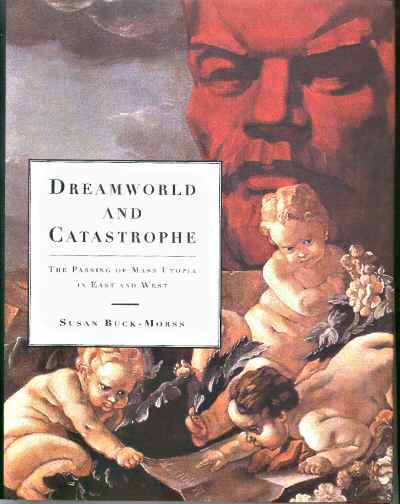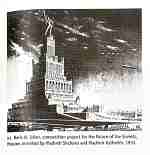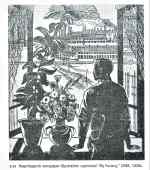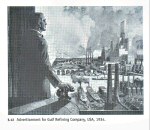
Book Review: Dreamworld and Catastrophe
by Gordon Fitch




|
Dreamworld and Catastrophe: The Passing of Mass Utopia in East and West by Susan Buck-Morss The MIT Press (2000) ISBN 0-262-02464-0 |
The construction of mass utopia was the dream of the twentieth century. It was the driving ideological force of industrial modernization in both its capitalist and socialist forms. The dream was itself an immense material power that transformed the natural world, investing industrially produced objects and built environments with collective, political desire. Whereas the night dreams of individuals express desires thwarted by the social order and pushed backward into regressive childhood forms, this collective dream dared to imagine a social world in alliance with personal appiness, and promised to adults that its realization would be in harmony with the overcoming of scarcity for all.
As the century closes, that dream is being left behind. ... [T]he mass-democratic myth of industrial modernity -- the belief that the industrial reshaping of the world is capable of bringing about the good society by providing material happiness for the masses -- has been profoundly challenged by the distintegration of European socialism, the demands of capitalist restructuring, and the most fundamental ecological constraints.
So begins Dreamworld and Catstrophe: it's the political and cultural frame in which an interesting and idiosyncratic view of the much of the popular art and other cultural artifacts of the 20th century, and especially of the Soviet Union and the United States, are considered, compared and related.
The book is divided into four very different and rather unconventional sections. The introduction, quoted above, leads to the arguments of the first section, which are presented in a "hypertextual" fashion, that is, an abstract theoretical development is coupled with a series of fragments largely referring to events "on the ground", so to speak. The two discourses occur in two parallel textual streams, one above and one below on each page, much as if the second were an annotation to the first, or perhaps the base of the first.
This structure is probably not as helpful as it was intended to be, but it is not obscurantist or difficult. The central idea of this first section, in a magisterially-delivered dicussion which I will not attempt to condense here, is to argue that the absolute violence and total power assumed by 20th-century states required legitimation in the material utopia which these states were supposed to bring forth.
That supposition in turn goes back to the idea of perfectable man and state, and of the "General Will" which began to appear in the 18th century and is associated with, for example, Rousseau. The framework of progress and perfectability so described is the setting for the ubiquitous and often savage ecstasy of populist utopianism enacted in 20th century Communism and, to some extent, capitalism, as well as other movements and ideologies. The cultural artifacts associated with this utopianism, especially in Russia, are the central subject of of this book.
The second and third sections deal with the way in which art and other features of popular culture were used to cast this imaginary world before the thirst of the suffering populace, for whom, of course, utopia was always tomorrow. The fourth section is a curious personal account of how the dissolution of the utopian vision worked out in the life of the author and her colleagues and associates.
The middle parts of the book, the second and third section, are probably more about Soviet than American culture. Nevertheless, the author never forgets that Soviet leaders, planners and visionaries were often looking over their shoulders at the United States; one is reminded of Mikoyan telling a reporter in the 1950s that the United States was much closer to communism than the USSR. Henry Ford, the man who made cheap cars and paid his workers enough to buy them was (ironically in view of some of his sympathies) a great hero in early Soviet society.
Some truly remarkable resonances are discovered, as, for instance, Stalin's vision of a tremendous building in Leningrad surmounted by a statue of Lenin himself; the correspondences to King Kong standing on top of the Empire State Building across the page are unmistakable once they are shown to us. And although King Kong was never shown to the public in the USSR, Stalin himself vetted Western movies to see if they were suitable for the people under his control, and there is every reason to believe that King Kong was one of them. King Kong, the character as well as the movie, is given quite a bit of attention, in fact, since it is not difficult to see in him the powerful, primordial natural man (or Nature itself) who rebels against the repressive, exploitive structure of the industrial state and climbs up and thus overcomes -- or becomes! -- its greatest monumnt.
Another remarkable, similar resonance, is that between a Soviet worker looking out a window at "his" factory, and an American business manager looking out at his -- or, probably, "his" in quotes, since by the first decades of the 20th century we are already very much in the epoch of alienated, non-proprietary managers as well as workers. (In twenty or thirty years he will find himself in the movies, in a gray flannel suit.)
In general, this consideration of the arts and styles the opposed and yet paired behemoths of the East and West is a tour de force which illuminates a great deal about the popular culture of the Soviet Union, especially its pre-Stalin experimental phase, of which I had formerly only seen scattered glimpses, as out of their context as a prehistoric fish. The striking work of the various post-Revolutionary artistic schools are matched up with the political and cultural currents which surrounded them, and these are compared when possible with similar ideas and images from the United States, many of them quite remarkable, like the King Kong- Lenin reflection.
We see as well what we might call the postmodern phase of Socialist Realism, the satire and irony of which Komar and Melamid are the most prominent exponents. Regardless of one's views of the political framework of the book -- fans of certain ideologies won't like it, and there is perhaps more difference between the utopianism of the two communities than is noticed -- almost anyone interested in art will find the two central sections absorbing and enlightening.
In the last part of the book, we are taken to a series of conferences which began before the fall of Berlin Wall and which ended after the dissolution of the Soviet Union. On one side of the conferences were those from the East Bloc, and on the other those from the West, the ideas of both parties complicated and, in a sense, balanced by each group's doubts about its own system and its curiosity about the other's. The breakdown of the East Bloc led to the destruction of the original equilibrium and thus to the conversation as it had been. To some extent this book might be seen as a way of continuing an exchange that had broken down, or broken apart, and so it, too, breaks out of the channels of academic discourse.
The book is heavily but unobtrusively annotated and has a considerable bibliography and a reasonably restrained index. The apparatus will gratify those who desire to pursue further research, tourism or intellectual archaeology in these largely untraveled regions.
Physically, this book is a very attractive production, profusely illustrated (including several color plates), with an excellent typeface on good paper, and generally good overall design, so that it is a pleasure to possess and read it for its physical form as well as its content. One can only wish it were physically larger to give the illustrations more room. Its virtues may console us a little for our departed utopias.
CV of the author: http://falcon.arts.cornell.edu/Govt/faculty/Buck-MorssCV.pdf
MIT Press book catalog URL: http://mitpress.mit.edu/catalog/author/default.asp?aid=700
Som other reviews online: http://www.reconstruction.ws/BReviews/revDreamworld.htm' http://www.amazon.com/exec/obidos/tg/detail/-/0262523310/ http://www.frontlist.com/detail/0262523310




 back to Contents page
back to Contents page